| ||
|---|---|---|
35th President of the United States Tenure Appointments Presidential campaign Assassination and legacy | ||
The following is a timeline of the presidency of John F. Kennedy from January 1, 1962, to December 31, 1962.
| ||
|---|---|---|
35th President of the United States Tenure Appointments Presidential campaign Assassination and legacy | ||
The following is a timeline of the presidency of John F. Kennedy from January 1, 1962, to December 31, 1962.
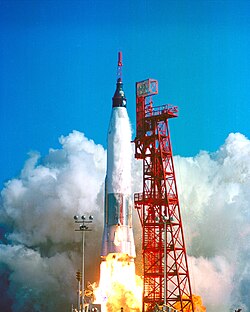
| | This section is empty. You can help by adding to it. (July 2019) |



The University of Notre Dame du Lac, known simply as Notre Dame, is a private Catholic research university in Notre Dame, Indiana, north of the city of South Bend. French priest Edward Sorin founded the school in 1842. The main campus covers 1,261 acres in a suburban setting and contains landmarks such as the Golden Dome, the Word of Life mural, Notre Dame Stadium, and the Basilica. Originally for men, the university did not formally accept undergraduate female students until 1972.
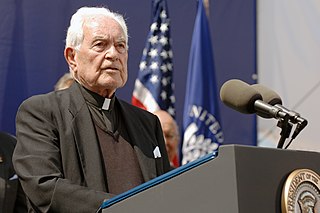
Rev. Theodore Martin Hesburgh, CSC was an American Catholic priest and academic who was a member of the Congregation of Holy Cross. He is best known for his service as the president of the University of Notre Dame for thirty-five years (1952–1987). In addition to his career as an educator and author, Hesburgh was a public servant and social activist involved in numerous American civic and governmental initiatives, commissions, international humanitarian projects, and papal assignments. Hesburgh received numerous honors and awards for his service, most notably the United States's Presidential Medal of Freedom (1964) and Congressional Gold Medal (2000). As of 2013, he also held the world's record for the individual with most honorary degrees with more than 150.
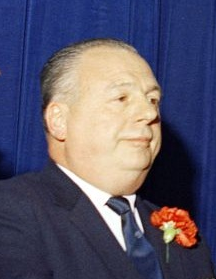
Michael Vincent DiSalle was an American attorney and politician from Ohio. A member of the Democratic Party, he served as mayor of Toledo from 1948 to 1950, and as the 60th governor of Ohio from 1959 to 1963.

Notre Dame Stadium is an outdoor football stadium in Notre Dame, Indiana, the home field of the University of Notre Dame Fighting Irish football team.

John Ignatius Jenkins, C.S.C. is a Catholic priest of the Congregation of the Holy Cross and the current president of the University of Notre Dame in Indiana. He previously served as its vice-president and associate provost. He replaced Edward Malloy as president.
The Rev. John Joseph Cavanaugh, C.S.C., an American Roman Catholic priest of the Congregation of Holy Cross, served from 1946 to 1952 as the 14th president of the University of Notre Dame, having previously served as its vice president since 1941.
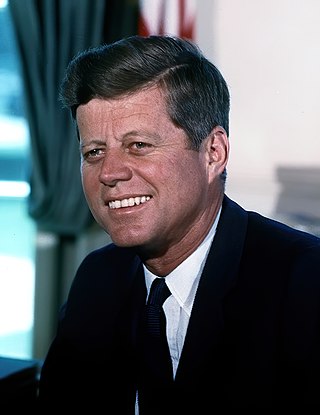
John Fitzgerald Kennedy, often referred to by his initials JFK and by the nickname Jack, was an American politician who served as the 35th president of the United States from 1961 until his assassination in 1963. He was the youngest person to assume the presidency by election and the youngest president at the end of his tenure. Kennedy served at the height of the Cold War, and the majority of his foreign policy concerned relations with the Soviet Union and Cuba. A Democrat, Kennedy represented Massachusetts in both houses of the U.S. Congress prior to his presidency.

John F. Kennedy's tenure as the 35th president of the United States, began with his inauguration on January 20, 1961, and ended with his assassination on November 22, 1963. A Democrat from Massachusetts, he took office following the 1960 presidential election, in which he narrowly defeated Richard Nixon, the then-incumbent vice president. He was succeeded by Vice President Lyndon B. Johnson.
The Laetare Medal is an annual award given by the University of Notre Dame in recognition of outstanding service to the Catholic Church and society. The award is given to an American Catholic or group of Catholics "whose genius has ennobled the arts and sciences, illustrated the ideals of the church and enriched the heritage of humanity." First awarded in 1883, it is the oldest and most prestigious award for American Catholics.

Theodore Hesburgh Library is the primary building of the University of Notre Dame's library system. The present-day building opened on September 18, 1963, as Memorial Library. In 1987, it was renamed Hesburgh Library, in honor of Rev. Theodore Hesburgh, C.S.C., who served as the university's president from 1952 to 1987. The library's exterior façade that faces the university's football stadium includes a large, 134-foot (41 m) by 68-foot (21 m) mural called Word of Life, or more commonly known as Touchdown Jesus. As of 2009, the library ranked as the 61st largest collection among research universities in the United States, with an estimated 3.39 million volumes.
John F. Kennedy, a Democrat from Massachusetts, was elected President of the United States on November 8, 1960, was inaugurated as the nation's 35th president on January 20, 1961, and his presidency ended on November 22, 1963, upon his assassination and death. The following articles cover the timeline of Kennedy's presidency:

The following events occurred in April 1962:

The University of Notre Dame was founded on November 26, 1842, by Father Edward Sorin, CSC, who was also its first president, as an all-male institution on land donated by the Bishop of Vincennes. Today, many Holy Cross priests continue to work for the university, including as its president. Notre Dame rose to national prominence in the early 1900s for its Fighting Irish football team, especially under the guidance of the legendary coach Knute Rockne. Major improvements to the university occurred during the administration of Rev. Theodore Hesburgh between 1952 and 1987 as Hesburgh's administration greatly increased the university's resources, academic programs, and reputation and first enrolled women undergraduates in 1972.
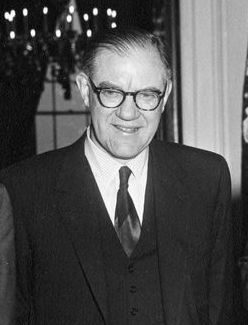
Roger M. Blough was the chairman of the board and chief executive officer of the United States Steel Corporation for 13½ years, from May 1955 through January 1969. In this position, he is best known for serving as the American steel industry's principal spokesman when the industry clashed in April 1962 with President John F. Kennedy on the issue of commodity steel prices.
The presidency of Lyndon B. Johnson began on November 22, 1963, when Lyndon B. Johnson became the 36th president of the United States following the assassination of President John F. Kennedy. His term ended on January 20, 1969.
The University of Notre Dame's annual commencement exercises are held each May, currently in the Notre Dame Stadium. The exercises award undergraduate and graduate degrees.
Robert Sam Anson was an American journalist and author. He was noted for his work as a contributing editor to Vanity Fair for over 20 years. He also wrote for other American magazines such as Esquire, Life, and The Atlantic. He authored six nonfiction books, including Gone Crazy and Back Again: The Rise and Fall of the Rolling Stone Generation, about Jann Wenner and his magazine.
The following is a timeline of the presidency of John F. Kennedy from his inauguration as the 35th president of the United States on January 20, 1961, to December 31, 1961.
The following is a timeline of the presidency of John F. Kennedy from January 1, 1963, to November 22, 1963, upon his assassination and death.

Hesburgh is a 2018 American documentary film directed by Patrick Creadon. The film follows the life of Fr. Theodore Hesburgh, President of the University of Notre Dame from 1952 through 1987, particularly during his time working on the U.S. Commission on Civil Rights. The film is drawn from archival footage, as well as interviews with family, colleagues at Notre Dame, politicians, journalists, and historians. Maurice LaMarche provides the voice of Hesburgh, narrating the documentary with words drawn from Hesburgh's writings and tapes.